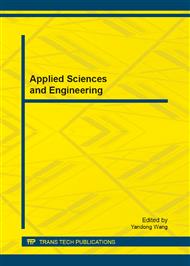[1]
R. H. Hayes, S. G. Wheelwright: Link manufacturing process and product life cycles. Harvard Business Review Vol. 57-1 (1979), pp.133-140.
Google Scholar
[2]
R. H. Hayes, S. G. Wheelwright: The dynamic of process-product life cycle. Harvard Business Review Vol. 57-2(1979), pp.127-136.
Google Scholar
[3]
E. Feitzinger, H. L. Lee: Mass customization at Hewlett-Packard: the power of postponement. Harvard Business Review Vol. 1-2 (1997), pp.116-121.
Google Scholar
[4]
M. H. Safizadeh, L. P. Ritzman, D. Sharma and C. Wood: An empirical analysis of the product-process matrix. Management Science Vol. 42-11 (1996), pp.1576-1591.
DOI: 10.1287/mnsc.42.11.1576
Google Scholar
[5]
S. S. Ariss, Q. Zhang: The impact of flexible process capability on the product-process matrix: an empirical examination. Production Economics Vol. 76 (2002), pp.135-145.
DOI: 10.1016/s0925-5273(01)00146-3
Google Scholar
[6]
S. Ahmad, R. G. Schroeder: Refining the product-process matrix. International Journal of Operations & Production Management Vol. 22-1 (2002), pp.103-124.
DOI: 10.1108/01443570210412097
Google Scholar
[7]
G. Stalk: Time - the next source of competitive advantage. Harvard Business Review Vol. 8 (1988), pp.41-52.
Google Scholar
[8]
J. Nadeau, R. M. Casselman: Competitive advantage with new product development: implications for life cycle theory. Journal of Strategic Marketing Vol. 16-5 (2008), pp.401-411.
DOI: 10.1080/09652540802480894
Google Scholar
[9]
M. S. Spencer, J. F. Cox: An analysis of the product-process matrix and repetitive manufacturing. International Journal of Production Research Vol. 33-5 (1995), pp.1275-1294.
DOI: 10.1080/00207549508930209
Google Scholar
[10]
T. J. Crowe, J. P. Nuño: Deciding manufacturing priorities: Flexibility, cost, quality and service. Long Range Planning Vol. 24-6 (1991), pp.88-95.
DOI: 10.1016/0024-6301(91)90047-r
Google Scholar
[11]
G. Anand, P. T. Ward: Fit, Flexibility and Performance in Manufacturing: Coping with Dynamic Environments. Production and Operations Management Vol. 13-4 (2004), pp.369-385.
DOI: 10.1111/j.1937-5956.2004.tb00224.x
Google Scholar
[12]
D. M. UPTON: The Management of Manufacturing Flexibility. California Management Review Vol. 36-2(1994), pp.72-89.
Google Scholar
[13]
T. J. Hill, R. Menda and D. M. Dilts: Using product profiling to illustrate manufacturing- marketing misalignment. Interfaces Vol. 28-4 (1998), pp.47-63.
DOI: 10.1287/inte.28.4.47
Google Scholar
[14]
A. J. Verdu-Jover, J. F. Llorens-Montes and V. J Garcia-Morales: Flexibility, fit and innovative capacity: an empirical examination. International Journal of Technology Management Vol. 30-1 (2005), pp.131-146.
DOI: 10.1504/ijtm.2005.006348
Google Scholar


